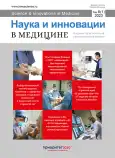Телемедицина в практической дерматовенерологии
- Авторы: Васильев-Ступальский Е.А.1,2, Измалков Н.С.1
-
Учреждения:
- ФГБОУ ВО «Самарский государственный медицинский университет» Минздрава России
- ГБУЗ Самарской области «Тольяттинский кожно-венерологический диспансер»
- Выпуск: Том 8, № 1 (2023)
- Страницы: 45-49
- Раздел: Общественное здоровье, организация и социология здравоохранения
- URL: https://journal-vniispk.ru/2500-1388/article/view/131499
- DOI: https://doi.org/10.35693/2500-1388-2023-8-1-45-49
- ID: 131499
Цитировать
Полный текст
Аннотация
Цель – оценить результативность оказания специализированной дерматовенерологической помощи с применением телемедицинских консультаций пациентам Самарской области с хроническими дерматозами – псориазом, атопическим дерматитом, экземой.
Материал и методы. Проведен сравнительный анализ телемедицинских консультаций в режиме реального времени 53 взрослых пациентов с установленными клиническими диагнозами, находившихся на стационарном и амбулаторном лечении. Результаты оценивались по длительности клинической ремиссии и показателям Дерматологического индекса качества жизни (ДИКЖ) через 12 месяцев после начала лечения. Дистанционные телемедицинские консультации проводились в Единой медицинской информационно-аналитической системе Самарской области (ЕМИАС) с помощью интегрированного сервиса видеоконференцсвязи (ВКС) TrueConf версия 7,5.
Результаты. Отмечена клиническая эффективность телемедицинских консультаций пациентов с хроническими рецидивирующими дерматозами. Продолжительность клинической ремиссии достоверно (р<0,05) увеличилась с 3,1 ± 0,7 мес. до 5,7 ± 0,4 мес. В группе сравнения данный показатель достоверно не отличался (p=0,05) от первоначального (3,2 ± 0,1 мес. и 3,3± 0,6 мес.). Показатель ДИКЖ по результатам телемедицинских консультаций улучшился в среднем на 45,1% и составил 12,4 ± 1,8 балла от исходного 22,6±1,6 балла (р<0,05). Приверженность терапии повышена у 58,5% пациентов (31 чел.), из которых сельские жители составили 81% (25 чел.). Дистанционное консультирование повышает доступность и удовлетворенность пациентов дерматовенерологического профиля Самарской области оказанной медицинской помощью.
Ключевые слова
Полный текст
Открыть статью на сайте журналаОб авторах
Евгений Александрович Васильев-Ступальский
ФГБОУ ВО «Самарский государственный медицинский университет» Минздрава России; ГБУЗ Самарской области «Тольяттинский кожно-венерологический диспансер»
Автор, ответственный за переписку.
Email: vsea@inbox.ru
ORCID iD: 0000-0003-1013-7855
SPIN-код: 1732-2847
канд. мед. наук, ассистент кафедры кожных и венерических болезней; главный врач
Россия, Самара; ТольяттиНиколай Сергеевич Измалков
ФГБОУ ВО «Самарский государственный медицинский университет» Минздрава России
Email: N.S.Izmalkov@samsmu.ru
ORCID iD: 0000-0002-0773-9524
канд. мед. наук, доцент кафедры общественного здоровья и здравоохранения ИПО, главный врач Клиник СамГМУ
Россия, СамараСписок литературы
- "On approval of the Concept of development of telemedicine technologies in the Russian Federation and its implementation plan". Order of the Ministry of Health of the Russian Federation No. 344, RAMS No. 76 dated 27.08.2001 (In Russ.). [«Об утверждении Концепции развития телемедицинских технологий в Российской Федерации и плана ее реализации». Приказ Министерства здравоохранения Российской Федерации № 344, РАМН № 76 от 27.08.2001].
- WHO. A health telematics policy in support of WHO’s Health-For-All strategy for global health development: report of the WHO group consultation on health telematics, 11-16 December, Geneva, 1997. Geneva, World Health Organization; 1998.
- "On the Basics of Public Health Protection in the Russian Federation". Federal Law No. 323-FZ of November 21, 2011 (In Russ.). [«Об основах охраны здоровья граждан в Российской Федерации». Федеральный закон от 21 ноября 2011 г. № 323-ФЗ].
- "On approval of the procedure for the organization and provision of medical care using telemedicine technologies". Order of the Ministry of Health of the Russian Federation No. 965n dated 30.11.2017 (Registered on 09.01.2018 No. 49577). (In Russ.). [«Об утверждении порядка организации и оказания медицинской помощи с применением телемедицинских технологий». Приказ Министерства здравоохранения Российской Федерации № 965н. от 30.11.2017 (Зарегистрирован 09.01.2018 № 49577)].
- Shaderkin IA, Shaderkina VA. Remote medical consultations of patients: what has changed in Russia in 20 years. Russian Journal of Telemedicine and E-Health. 2021;7(2):7-17. (In Russ.). [Шадеркин И.А., Шадеркина В.А. Дистанционные медицинские консультации пациентов: что изменилось в России за 20 лет. Российский журнал телемедицины и электронного здравоохранения. 2021;7(2):7-17]. doi: 10.29188/2712-9217-2021-7-2-7-17
- Morozov SP, Vladzymyrskyy AV, Simenyura SS. The quality of primary direct-to-consumer telemedicine consultations (by results of testing telemedicine services). Doctor and information technologies. 2020;1:52-62. (In Russ.). [Морозов С.П., Владзимирский А.В., Сименюра С.С. Качество первичных телемедицинских консультаций «пациент – врач» (по результатам тестирования телемедицинских сервисов). Врач и информационные технологии. 2020;1:52-62]. doi: 10.37690/1811-0193-2020-1-52-62
- Zheleznyakova IA, Khelisupali TA, Omelyanovskiy VV, Tishkina SN. Application of foreign experience of telemedicine services in the Russian Federation. Medical Technologies. Assessment and Choice. 2020;40(2):26-34. (In Russ.). [Железнякова И.А., Хелисупали Т.А., Омельяновский В.В., Тишкина С.Н. Анализ возможности применения зарубежного опыта оказания телемедицинских услуг в Российской Федерации. Медицинские технологии. Оценка и выбор. 2020;40(2):26-34]. doi: 10.17116/medtech20204002126
- Da Rosa MSG, et al. Telemedicine as a Health Promotion Tool: a Multidisciplinary Vision. Journal of the International Society for Telemedicine and eHealth. 2017;5.
- Saraiva A., Sousa MCB, Nunes J. Internet of medical things: first steps in systematization. Journal of the International Society for Telemedicine and eHealth. 2017;5. doi: 10.29188/2542-2413-2017-3-3
- Qadir MA, Hasnain A. E-Health System: A Tool for Investigations on Demographic Distribution Pattern of Dermal Diseases in Remote Beneficiary. Russian Journal of Telemedicine and E-Health. 2015;1.
- Massone C, Wurm EM, Hofmann-Wellenhof E, Soyer HP. Teledermatology: update. Semin Cutan Med Surg. 2008;27:101-105. doi: 10.1016/j.sder.2007.12.002
- Resources and activities of dermatovenerological organizations. The incidence of sexually transmitted infections, infectious skin diseases and skin diseases for 2019–2020 (statistical materials). M., 2021. (In Russ.). [Ресурсы и деятельность организаций дерматовенерологического профиля. Заболеваемость инфекциями, передаваемыми половым путем, заразными кожными болезнями и заболеваниями кожи за 2019–2020 годы (статистические материалы). М., 2021]. Available et: https://mednet.ru/napravleniya/mediczinskaya-statistika
- Kubanova AA, Martynov AA, Lesnaya IN, et al. Telecommunication technologies in the service of dermatovenerology. Vestnik of dermatology and venereology. 2010;5:55-8. (In Russ.). [Кубанова А.А., Мартынов А.А., Лесная И.Н., и др. Телекоммуникационные технологии на службе дерматовенерологии. Вестник дерматологии и венерологии. 2010;5:55-8].
- Martynov AA., Pirogova EV. Efficiency of information technologies in the process of providing specialized dermatovenerological care to the population of the Russian Federation. Vestnik of dermatology and venereology. 2011;5:2-31. (In Russ.). [Мартынов А.А., Пирогова Е.В. Эффективность информационных технологий в процессе оказания специализированной дерматовенерологической помощи населению Российской Федерации. Вестник дерматологии и венерологии. 2011;5:2-31].
- Martynov AA, Vlasova AV. The main directions of strategic development of dermatovenereological care. Pharmateca. Dermatology/Allergology. 2017;2:56-63. (In Russ.). [Мартынов А.А., Власова А.В. Основные направления стратегического развития дерматовенерологической помощи. Фарматека. Дерматология/Аллергология. 2017;2:56-63].
- Parsi K, Chambers CJ, Armstrong AW. Cost-effectiveness analysis of a patient-centered care model for management of psoriasis. J Am Acad Dermatol. 2012;66(4):563-570. doi: 10.1016/j.jaad.2011.02.022
Дополнительные файлы











